Management of the University Museum, the University of Tokyo, Japan.

Professor Yoshihiro Nishiaki
Director,
The University Museum, the University of Tokyo, Japan.
The University of Tokyo, founded in 1877, was originally equipped with a series of educational museums attached to colleges and/or departments to promote research and education using original scientific materials. However, these museums were abandoned in 1925, following the Great Kanto Earthquake that reduced the university to ruins. Later in 1965, the university founded the University Museum, the University of Tokyo (UMUT) with the aim of preserving the scientific materials scattered across the university as an inter-faculty institute to use them for education and research. In 1996, the UMUT was substantially revamped to accommodate a newly emerging demand from the public to open the university’s resources for public education as well.
Since its foundation, the UMUT has been unique in that it served as a platform for interdisciplinary research and education. Instead of controlling the research materials stored at various colleges and/or departments, the major mission of the UMUT has been to compile them to produce innovative research areas. For this purpose, the UMUT holds 17 material departments related to a range of traditional disciplines, from planetary science, geology, biology, and anthropology, to archeology. Simultaneously, it has three research departments to exploit the materials for new research disciplines, two departments for laboratory sciences such as radiocarbon dating and analytical chemistry, and four project departments for studying the role models of the university museums themselves. The present paper will address the current activities of the UMUT and issues encountered for its management with reference to virtual technology that is expected to play a major role in this endeavor.
This will be a recorded session.
Total Visits : 9542